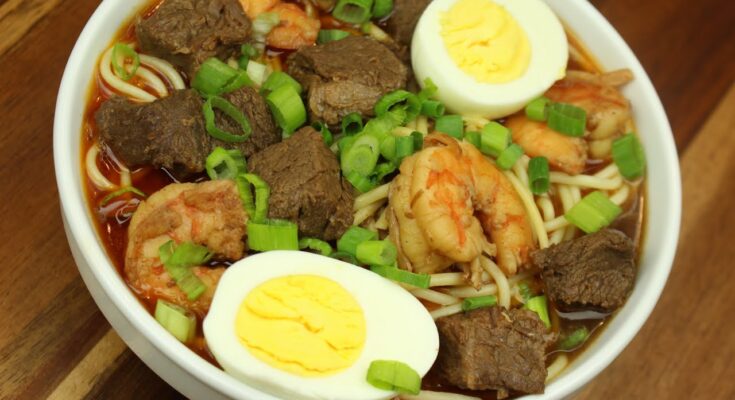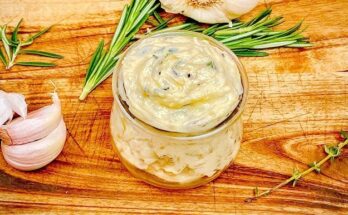Yakamein Recipe: If you’ve ever strolled through the streets of New Orleans or peeked into a soulful kitchen, chances are you’ve heard whispers of a legendary noodle soup called Yakamein—or “Old Sober,” as locals affectionately call it. It’s a flavor-packed, comfort-filled, no-nonsense dish with roots as deep as a jazz melody. Think of it as the lovechild of Asian noodle soup and good ol’ Creole cooking. Beefy broth, spaghetti noodles, hard-boiled eggs, green onions, and that unforgettable hit of Cajun spice—Yakamein is the ultimate hangover cure and weeknight comfort meal all rolled into one.
In this article, we’re not just giving you a list of ingredients and telling you to “figure it out.” Nope. We’re walking you through a step-by-step guide, showing you exactly how to bring this bowl of magic to life. Whether you’re craving something hearty, trying to impress friends with a cultural gem, or just want to cook up something new, this recipe’s got your back.
Let’s get into the nitty-gritty of this iconic dish. We’ll talk history, ingredients, how to make it, and even how to remix it to your taste. So grab your pot and spoon—Yakamein’s calling.
What is Yakamein?
Yakamein is a unique fusion of African-American and Asian culinary traditions, famously found in New Orleans but with roots that stretch across continents and generations. At its core, it’s a beef noodle soup—but don’t let that simple description fool you. It’s far more than just broth and noodles. Yakamein packs deep umami flavor, a warm kick from Creole spices, and soul-satisfying richness from slow-cooked beef.
Traditionally, the dish includes spaghetti noodles, savory beef broth, chunks of tender meat (usually beef chuck or stew meat), hard-boiled eggs, and a scattering of green onions. The broth often gets its complexity from soy sauce, garlic powder, onion powder, and Cajun or Creole seasoning, making every slurp a burst of bold flavor.
One of the beautiful things about Yakamein is its adaptability. It’s a street food, a hangover cure, a Sunday dinner, and a cultural symbol all rolled into one. Whether made by a street vendor, grandma, or chef, Yakamein is all about flavor, simplicity, and heart.
If you’ve never had the pleasure of trying it, you’re in for something truly special. And if you’re already a fan? Well, you’re about to learn how to make it right at home—exactly the way it should be.
A Brief History of Yakamein
Yakamein’s origin story is as rich and layered as its broth. While no one knows exactly where it came from, it’s widely believed to have been born from a cultural blend of Chinese immigrants and African-American communities in New Orleans around the early 20th century.
Back in the day, Chinese immigrants worked on the railroads and in port areas, bringing their cooking styles and ingredients to the South. At the same time, African-American cooks in New Orleans, steeped in the traditions of soul food and Creole cooking, began integrating these new flavors into their own dishes. What resulted was this flavorful mash-up: a noodle soup that borrowed techniques and ingredients from both cultures.
Yakamein remained relatively under-the-radar outside of Louisiana for decades, passed down through families and served in local restaurants and food stalls. It’s often associated with second lines, Mardi Gras parades, and hangover cures, earning it the nickname “Old Sober.”
Some people even credit a New Orleans chef named Ms. Linda Green, also known as the “Yakamein Lady,” for helping keep the dish alive and relevant. Thanks to folks like her, this humble, powerful bowl of soup is finally getting the attention it deserves across the U.S. and beyond.
Why is Yakamein Known as “Old Sober”?
“Old Sober” isn’t just a cute nickname—it’s a reputation. Yakamein earned this title because of its legendary ability to cure hangovers, especially after a wild night out during Mardi Gras or other New Orleans festivities.
So, what makes it such a miracle worker?
Well, the combination of protein, salt, carbs, and spices helps rehydrate the body, boost electrolytes, and bring you back to life. Think about it: you’ve got a warm broth that comforts your stomach, beef for protein, spaghetti noodles for carbs, eggs for extra fuel, and spices to wake up your taste buds. It’s like a cozy blanket, a wake-up call, and a healing potion all in one.
Locals swear by it, and many people claim they feel better instantly after slurping down a bowl. It’s often sold near party hotspots or during events for that exact reason. Even if you’re not recovering from a night out, Yakamein’s restorative powers can warm your soul after a long day or lift you up when you’re feeling under the weather.
What Makes Yakamein Unique?
Let’s face it: there are plenty of noodle soups out there. Ramen, pho, udon, chicken noodle—you name it. But Yakamein holds its own in this crowded space, and here’s why.
First off, it blends two bold culinary cultures—Asian and Creole. That means it has depth from soy sauce and garlic, heat from Cajun spice, and soul from the way it’s prepared. The beef is often simmered until it’s melt-in-your-mouth tender, and the broth develops rich, meaty notes with subtle kicks of spice and savoriness.
Secondly, the use of spaghetti noodles instead of traditional Asian noodles gives it a unique texture and accessibility. It’s a dish made with simple ingredients most people already have in their kitchens, which is part of its charm.
And then there’s the presentation: a beautiful bowl topped with a sliced hard-boiled egg, fresh green onions, and maybe even a squirt of hot sauce if you’re feeling bold. It’s comfort food, yes—but elevated comfort food.
It’s easy to make, packed with flavor, and endlessly customizable. Whether you’re feeling fancy or just want something fast and filling, Yakamein hits the spot every single time.
Ingredients You’ll Need
Want to cook up a big, warm bowl of Yakamein? You’ll need a few essentials. Most of these are pantry staples or easily found at your local grocery store.
Beef Options
- Beef chuck roast (preferred for tenderness)
- Stew beef or brisket (optional alternatives)
- Beef bouillon or base (to boost flavor)
Choose a cut with some fat for richness. Slow-cooked beef is the heart of the broth.
Noodles
- Spaghetti noodles (classic choice)
- Optional: ramen or rice noodles (if you want a twist)
Spaghetti gives that down-home texture that’s key to Yakamein.
Seasonings & Spices
- Soy sauce
- Garlic powder
- Onion powder
- Cajun seasoning or Creole seasoning
- Black pepper
- Paprika
- Bay leaves
- Salt to taste
These create the flavor base for the beef broth.
Toppings
- Hard-boiled eggs
- Green onions (sliced)
- Hot sauce
- Optional: parsley or cilantro for garnish
The egg is traditional and adds protein and visual appeal.
Optional Add-Ins
- Shrimp or chicken for a protein variation
- Beef liver or oxtail for a more traditional, hearty twist
- Mushrooms or bok choy for added vegetables
These extras can personalize the dish to your taste.
Kitchen Tools Required
Before you jump into making Yakamein, it helps to have the right tools at your side. Nothing fancy—just some basic kitchen equipment that makes the whole process smoother.
Here’s what you’ll need:
- Large stockpot or Dutch oven – This is essential for simmering your beef and building that rich broth. A pot with a lid is ideal.
- Medium saucepan – You’ll use this for boiling your eggs and cooking your noodles separately.
- Sharp knife & cutting board – For slicing green onions, trimming beef, and prepping any additional ingredients.
- Tongs or slotted spoon – To remove beef from the pot easily.
- Strainer or colander – Useful for draining the noodles once cooked.
- Ladle – Helps when pouring the hot broth into your serving bowls.
- Measuring spoons & cups – To ensure all your seasonings are perfectly balanced.
- Bowls for serving – Wide, deep bowls work best for this soup-based dish.
That’s pretty much it. You likely already have most of these in your kitchen. With these tools on hand, you’re ready to dive into the Yakamein-making process without a hitch.
Preparation Tips Before Cooking
Before we dive head-first into cooking, there are a few prep steps you should follow to save time and ensure everything flows smoothly in the kitchen.
- Start with quality beef
Choose a well-marbled cut like chuck roast. If you’re in a rush, go for pre-cut stew meat, but remember: flavor builds with time, so tenderizing it through slow simmering is key. - Boil your eggs in advance
Hard-boiled eggs take around 10–12 minutes. You can make them ahead and store them in the fridge for easy slicing when it’s time to serve. - Pre-chop garnishes
Slice your green onions, chop any herbs, and set them aside in small bowls. This little mise en place makes final assembly a breeze. - Measure your spices
Line up your seasoning and spice blends in advance. This way, you don’t risk over-seasoning when tasting the broth later on. - Use broth boosters
While you’re simmering beef to build a natural broth, you can also enhance the richness with beef bouillon or concentrated base for added umami punch. - Cook noodles separately
Don’t cook spaghetti in the beef broth. Cooking them separately keeps the broth from getting starchy and murky.
With these steps in place, you’ll be moving through the recipe like a seasoned pro. Let’s get cooking!
Step-by-Step Yakamein Recipe
Time to put it all together. This isn’t one of those recipes that take all day—but it does reward patience. The longer your beef simmers, the better your broth gets. Here’s how to make it, step by step:
Step 1: Preparing the Beef
Start by seasoning your beef (usually flank steak or brisket) with salt, pepper, and a dash of Creole seasoning. Brown it in a pot to lock in the flavor, then set it aside. This gives the meat a rich, savory base that defines Yakamein’s unique taste.
Step 2: Making the Broth
In the same pot, add beef stock, soy sauce, Worcestershire sauce, and a touch of hot sauce. Simmer the browned beef in this mixture until tender and infused with flavor—about an hour or more for the best result.
Step 3: Boiling the Eggs
Hard-boil your eggs, peel them, and set them aside for topping later. They’ll add protein and balance to your bowl.
Step 4: Cooking the Noodles
Cook your spaghetti noodles until tender but firm, then drain and rinse to prevent sticking.
Step 5: Assembling Your Bowl
Layer your noodles, sliced beef, and broth in a bowl. Top with boiled eggs, chopped green onions, and a sprinkle of Creole seasoning. Serve hot and enjoy the soulful, comforting taste of New Orleans’ favorite noodle soup!
How to Store and Reheat Yakamein
One of the best things about Yakamein—besides its bold flavor—is that it stores and reheats like a dream. Whether you’re making it ahead for the week or saving leftovers, you’ll want to store each component separately to keep everything tasting fresh.
Storing Yakamein Properly
- Broth: Let the broth cool to room temperature, then pour it into an airtight container. It will keep in the fridge for up to 5 days or in the freezer for up to 3 months.
- Beef: Store the cooked and shredded beef separately from the broth to maintain its texture. Again, airtight containers are your best friend here.
- Noodles: Noodles can get soggy if stored in broth. Rinse them with cold water after cooking, toss them lightly in a bit of oil, and store in a zip-top bag or container. They’ll last in the fridge for about 3 days.
- Eggs and toppings: Keep hard-boiled eggs in their shells for longer freshness—up to 1 week in the fridge. Sliced green onions should be stored in a sealed container or wrapped in damp paper towels inside a ziplock bag.
How to Reheat Without Losing Flavor
- Reheat the broth in a saucepan over medium heat until it begins to simmer. If it tastes a little flat, refresh it with a dash of soy sauce or Cajun spice.
- Warm the beef in the broth, or separately in a pan with a splash of water to prevent drying.
- Noodles can be reheated briefly in hot water or in the microwave with a damp paper towel over the bowl.
- Assemble just as you did before: noodles, beef, broth, egg, green onion. Boom—day-old Yakamein that tastes just as good (if not better) than day one.
Pro Tip: Store in portioned containers for easy grab-and-go lunches or meal prep.
Variations of Yakamein
Classic beef Yakamein is the real deal, but the beauty of this dish lies in its flexibility. Whether you’re pescatarian, vegetarian, or just want to shake things up, these variations let you enjoy all that bold Yakamein flavor with a personal twist.
Seafood Yakamein
Swap out the beef for shrimp, crab, or catfish and watch this dish take on a whole new life.
- Use seafood stock or add fish sauce to the broth for depth.
- Cook shrimp separately and toss them in just before serving to prevent overcooking.
- A touch of lemon juice or Old Bay seasoning can really enhance the seafood flavors.
This version is lighter, faster to make, and perfect for seafood lovers looking for something comforting but not too heavy.
Chicken Yakamein
For a leaner take, chicken is your go-to. Use boneless chicken thighs or shredded rotisserie chicken.
- Boil chicken in water with the same seasonings as the beef broth.
- Add a spoon of chicken bouillon for more flavor.
- Simmer for about 30–40 minutes if cooking raw chicken.
The result? A lighter broth that still hits all the right savory, spicy notes. This version is also kid-friendly and great for weeknight meals.
Vegan Yakamein
Yes, even plant-based eaters can enjoy Yakamein!
- Use vegetable broth or mushroom broth as your base.
- Swap meat with portobello mushrooms, tofu, or jackfruit for that hearty bite.
- Season aggressively—vegan broth needs a good blend of garlic, onion, soy sauce, Cajun spice, and a little nutritional yeast for umami.
Top with a vegan egg alternative or skip it altogether and add extra veggies like bok choy, bean sprouts, or scallions.
The result? Still warming. Still soulful. Still Yakamein.
Health Benefits and Nutritional Info
While Yakamein is comfort food at its core, it can also offer some impressive nutritional perks—especially when made at home where you control the ingredients.
What’s Inside a Bowl of Yakamein?
- Protein: Between the beef and the hard-boiled egg, you’re getting a solid dose of protein to keep you full and fuel your muscles.
- Carbs: Spaghetti noodles are your carb source, helping replenish energy (especially important if you’re recovering from a long night out).
- Vitamins & Minerals: Depending on your toppings, you can get B-vitamins, iron, zinc, and other minerals from the beef and egg, plus vitamin K and C from green onions.
- Hydration & Electrolytes: The broth isn’t just tasty—it also helps hydrate you, especially with the added salt and spices that make it a hangover helper.
Make It Healthier
- Use whole-wheat or gluten-free noodles.
- Trim visible fat from beef or use a leaner cut.
- Add veggies like spinach, cabbage, or kale for fiber and nutrients.
- Use low-sodium soy sauce and adjust your salt levels accordingly.
Whether you’re counting macros or just trying to eat better, Yakamein can fit into your diet without sacrificing flavor.
Tips for Serving Yakamein
Let’s be honest—how you serve Yakamein is half the experience. A well-prepared bowl should be a feast for the eyes and the stomach. Here’s how to make yours shine:
Presentation Tips
- Use a wide, deep bowl so the broth doesn’t spill over the edges.
- Arrange noodles first, then pile beef neatly in the center.
- Halve your hard-boiled egg and lay it gently on top—don’t bury it!
- Finish with a generous sprinkle of green onions and a few shakes of hot sauce or Creole seasoning for color.
Serving Ideas
- Pair with a side of cornbread or crusty French bread for dipping.
- Offer optional toppings at the table: hot sauce, soy sauce, lemon wedges, extra green onions, or crushed red pepper.
- Want a drink pairing? Yakamein goes surprisingly well with a light lager or iced tea.
Yakamein is a humble dish, but a little extra care in the presentation can make it feel like a five-star meal.
Common Mistakes to Avoid
Yakamein may be simple to make, but there are a few pitfalls that can mess with your final bowl. Keep these in mind:
- Overcooking the noodles
Mushy noodles can ruin the dish. Cook them separately and rinse immediately with cold water. - Under-seasoning the broth
Taste as you go. The broth should be bold, rich, and full of flavor—not bland. - Skipping the egg
The hard-boiled egg isn’t just decorative—it adds creaminess and richness. Don’t leave it out unless you absolutely must. - Cooking noodles in the broth
This makes the broth cloudy and adds unnecessary starch. Always cook and store noodles separately. - Using low-quality beef
Cheap cuts full of gristle won’t break down well. Stick to chuck roast or stew meat for best results. - Not letting the beef simmer long enough
Rushing the simmering process won’t give you tender meat or developed flavor. Be patient.
Remember, great Yakamein comes from a balance of good ingredients, slow cooking, and proper assembly.
FAQs about Yakamein Recipe
1. Can I make Yakamein in a slow cooker?
Yes! Just sear your beef first, then add it to the slow cooker with the broth ingredients and cook on low for 6–8 hours. Finish with noodles and toppings when ready to serve.
2. Is Yakamein spicy?
It can be, but it doesn’t have to be. Adjust the level of Cajun seasoning and hot sauce to your preference. Start mild and build up the heat.
3. Can I use ramen noodles instead of spaghetti?
You can, but spaghetti is more traditional for Yakamein. Ramen noodles will give it a different texture but still taste great.
4. What’s the best cut of beef for Yakamein?
Beef chuck roast is ideal because it’s affordable, flavorful, and gets tender with long simmering. You can also use stew beef or brisket.
5. Can I freeze Yakamein?
You can freeze the broth and beef together, but it’s best to cook noodles fresh when ready to eat. Frozen noodles tend to get mushy upon reheating.
Conclusion
There’s something magical about Yakamein. It’s more than just beef noodle soup—it’s a taste of New Orleans history, a hug in a bowl, and a one-way ticket to flavor town. Whether you’re craving comfort, nursing a hangover, or just looking for something new to cook, this dish delivers every time.
From its bold broth to its tender beef and nostalgic use of spaghetti noodles, Yakamein offers something unique in every bite. And the best part? You can customize it to your heart’s content—seafood, chicken, or even vegan. Once you master this step-by-step recipe, it might just become a regular in your kitchen.
So grab your pot, stock up on some seasonings, and get cooking. Old Sober is calling your name.



